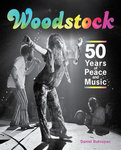 Narrowsburg
NarrowsburgLight Rain Fog/Mist, 43°
Wind: 8.1 mph
 Narrowsburg
Narrowsburg

Bethel Woods Center for the Arts (BWCA) hosted a celebration of the publication launch of “Woodstock: 50 Years of Peace and Music” Sunday, July 21, featuring a group of panelists, all having contributed to the book in some way.
The book is a collaborative effort, with music journalist and published author Daniel Bukszpan at the helm and Karen Matsu Greenberg as the producer and project manager. More than 350 hours of interviews with some of the thousands who attended the rock festival make up the meat of the book.
The panel featured documentarian Amalie R. Rothschild, whose never-before-seen photos of the behind-the-scenes experience at Woodstock are heavily featured in the book; The River Reporter photojournalist Jonathan Charles Fox, who also took various photos featured the publication and whom Greenberg also credited with “showing [her] the heart of Sullivan County”; Woodstock attendee Gail Hayssen; and, of course, Bukszpan, the author, interviewer and compiler of the book.
Bukszpan said he realized very early on in the writing process that his original plan was not going to bring him enough content. The musicians who are still around didn’t want to talk about Woodstock anymore; there was nothing new they could say. Upon contacting Skip Taylor, the manager for Canned Heat, he found out Taylor had already been approached by five other authors, each with the same pitch. “That [conversation] got me thinking, this has to be different somehow. This has to be a fresh take.”
His saving grace ended up being the Woodstock audience. “Almost everyone I knew personally who was around my age had an uncle or an aunt who had been to Woodstock and was dying to talk about it.” He asked around on social media and “the floodgates opened.” Suddenly, the content snowballed into his hands.
“As far as the general public goes, we all know Jimi Hendrix played ‘The Star Spangled Banner.’ But the general public didn’t know [is that there was] a naked couple on a motorcycle going to the festival. They didn’t know that you could hear The Who playing miles away and that you [could] just get to the festival grounds if you followed the sound. I didn’t know that people had no shelter of any kind and slept in the mud while it rained on them all night.
“None of that stuff appears in any of the Woodstock legends. And it’s not because anyone is trying to keep it out. In the two years that I was working on this book, I was just never really able to find these kinds of accounts—and there were 400,000 people there. To me, that seemed like a huge oversight.”
The photograph on the book’s cover (beneath Elliott Landy's photo on jacket) gives you a good idea of what 400,000 looks like—a powerful depiction of the sardine-packaged mass of the audience. It’s one of many of Rothschild’s photographs; she is credited on the title page as providing “principal photography” for this 50th anniversary publication. “It was very rare for a woman to be such a constant presence in the early days of rock n’ roll,” Greenberg said of Rothschild before inviting her to the podium. The statement is true, and despite that, Rothschild’s work has lived on as iconic and recognizable images.
“A lot of people ask me, ‘How did you get to Woodstock?’ Well, the real question is how did I even have the access to start taking pictures,” Rothschild said. She began as a member of NYU’s first graduating class of the Institute of TV, a department located in a building that was next door to what eventually became the Fillmore East. The legendary rock-concert space was basically staffed by NYU students, and that’s how she fell into photographing the timeless performances at the Fillmore East, and also working with the Joshua Light Show.
The Fillmore East “was the laboratory for the invention of all the technical innovations that made the presentation of rock music transform into rock theatre.” According to Rothschild, those same NYU grads made up the whole tech staff that put Woodstock together.
Rothschild arrived at Woodstock to perform the light show, but only performed the first night, after which the entire light-show screen disappeared. “We were always told it was taken down because of the winds, but what we discovered was, in fact, it was taken down by the staff to be cut up into pieces to use as tarps to cover equipment when the rains came.”
Much of Rothschild’s photography was revealed to the world for the first time in “Woodstock: 50 Years of Peace and Music.”
Rothschild ceded the podium to the River Reporter’s “In My Humble Opinion” columnist Jonathan Charles Fox. Always a joker, Fox said, “I know most of you are thinking, ‘He can’t possibly be old enough to have been at Woodstock’... Why are you laughing?”
Although he came into photography “very late” in his career, Fox has made a name for himself in our neck of the woods as an award-winning photojournalist. It was his connection to the festival, the area and BWCA, along with his photography, that landed him on the stage with the others. His photos are scattered throughout the book: original Woodstock artifacts like Joplin’s necklace and original signage, relevant documents like town permits, recent shots of Yasgur’s farm-grounds and a picture of Duke Devlin and himself. (Dharma the Wonder Dog also gets her own acknowledgment in the back.)
“My career has taken me all over the world, but I relocated here, right here to Sullivan County, long before BWCA was put on the earth, and I was here for the ground-breaking [ceremony], for almost every concert. This place means a great deal to me.”
Fox went on to read “Janis Joplin Changed My Life,” a piece he wrote 10 years ago for the festival’s 40th anniversary. Read it on page 18.
Gail Hayssen said she was “thrilled and honored.” You can spot her 14-year-old self on page 132, right beneath a heading that needs to be included in any serious publication about Woodstock: “Karen asked me, ‘Do you mind if we put your photo on the ‘drug’ page?’
“We never wanted for food, for water; —we brought so much with us, we were able to share with everybody. Same thing with the drugs! We brought enough pot and hash for everybody.” She spoke about how she was fourth-row-center, on a log her friends used as a bench in the mud, close enough to chuck a joint to Michael Lang. “This cute, curly-haired guy on stage... When I look at the distance now, I think, ‘How did that joint fly the whole way?’ But it did! I threw it across, he caught it and gave me a big smile; whether he remembers this or not, I never met him, but we thought he was such a cute guy.”
In BWCA’s Event Gallery, Woodstock memories were shared with joy by people brought together by a book that shares the very same within its pages. Fifty years later, with the setlists listened to, the recordings bought and memorized by the masses, these accounts from the people may be all that truly matter.
“I was acting as a custodian of people’s memories and experiences, and I got to feel very honored that they wanted to share them with me and trusted me to do it right,” Bukszpan said. “It was very important to me to do right by these people, for that reason.”
Comments
No comments on this item Please log in to comment by clicking here